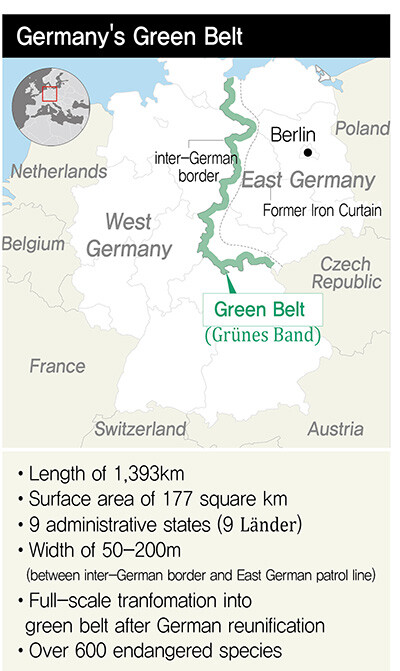hankyoreh
Links to other country sites 다른 나라 사이트 링크
Germany’s green belt serves as model for Korea’s DMZ

The German Green Belt (Gruenes Band) is an example of a border region that serves as a model for the future of the Korean Peninsula’s DMZ. The “Iron Curtain” -- the old border that divided East and West Germany for over three decades -- has been transformed into a setting for the preservation of nature and ecological and historical tourism, emerging as a green belt not just for Germany but for all of Europe.
The German Green Belt is 1,393km long, and 50–200m wide, with an area of 177 square kilometers that passes through nine Land (state) governments. It encompasses one national park, three biosphere reserves, and 136 nature reserve areas. The area is inhabited by around 5,200 species of flora and fauna, over 600 of which are endangered, according to scientific studies.
What allowed a setting of Cold War division and death to transform into a symbol of reconciliation and peace was the Basic Treaty on relations between East and West Germany that was signed in 1972. The year after the treaty was concluded, the two sides established “border committees” to cooperate on areas including water resources, energy, and disaster prevention.
When the Berlin Wall was torn down in 1989, the “zone of death” at the military demarcation line began its full-scale transformation into a green belt of peace. The “Gruenes Band” project was carried out as a way of preserving a border region that had become an ecological treasure trove. The environmental group BUND received government support to spearhead a campaign in connection with the project. Joint government and non-government participation was ensured to minimize social conflict over development and preservation. In the space of three decades, the border region was wiped clean of its marks of past division.
The process was not without its difficulties. After reunification, land on the border reverted to its past ownership, placing it outside state administrative control; some of it was sold to companies, raising the threat of ecological damage. But the German government purchased and nationalized privately owned land on the border in order to protect its ecosystem, and with its return of the land to state governments under designation area as “National Natural Heritage” in 2003, it laid the groundwork for the border region’s preservation and use.
During the 21st century, the German Green Belt has transformed into a supranational environment campaign. After visiting Germany in 2002, Mikhail Gorbachev, the former Soviet leader, advocated a “European green belt” campaign to expand the belt to the north and south. The German Green Belt was extended to a length of 12,500km, passing through 24 countries in Scandinavia, the Baltic republics, Central Europe, and the Balkans.
“The German Green Belt hold great implications for the direction of the DMZ’s preservation and use, in that it was a well-harmonized mixture of preservation and restoration with a tourism model that increased its symbolic value as a space for sustainable development,” said Park Eun-jin, director of administrative planning at the National Institute of Ecology.
“We need to include local governments, NGOs, and local residents in the process to minimize societal conflicts surrounding the DMZ’s preservation and development,” Park suggested.
By Park Kyung-man, North Gyeonggi correspondent
Please direct comments or questions to [english@hani.co.kr]

Editorial・opinion
![[Column] Season 2 of special prosecutor probe may be coming to Korea soon [Column] Season 2 of special prosecutor probe may be coming to Korea soon](https://flexible.img.hani.co.kr/flexible/normal/500/300/imgdb/original/2024/0426/3317141030699447.jpg) [Column] Season 2 of special prosecutor probe may be coming to Korea soon
[Column] Season 2 of special prosecutor probe may be coming to Korea soon![[Column] Park Geun-hye déjà vu in Yoon Suk-yeol [Column] Park Geun-hye déjà vu in Yoon Suk-yeol](https://flexible.img.hani.co.kr/flexible/normal/500/300/imgdb/original/2024/0424/651713945113788.jpg) [Column] Park Geun-hye déjà vu in Yoon Suk-yeol
[Column] Park Geun-hye déjà vu in Yoon Suk-yeol- [Editorial] New weight of N. Korea’s nuclear threats makes dialogue all the more urgent
- [Guest essay] The real reason Korea’s new right wants to dub Rhee a founding father
- [Column] ‘Choson’: Is it time we start referring to N. Korea in its own terms?
- [Editorial] Japan’s rewriting of history with Korea has gone too far
- [Column] The president’s questionable capacity for dialogue
- [Column] Are chaebol firms just pizza pies for families to divvy up as they please?
- [Column] Has Korea, too, crossed the Rubicon on China?
- [Correspondent’s column] In Japan’s alliance with US, echoes of its past alliances with UK
Most viewed articles
- 1Why Kim Jong-un is scrapping the term ‘Day of the Sun’ and toning down fanfare for predecessors
- 2‘We must say no’: Seoul defense chief on Korean, USFK involvement in hypothetical Taiwan crisis
- 3After election rout, Yoon’s left with 3 choices for dealing with the opposition
- 4Two factors that’ll decide if Korea’s economy keeps on its upward trend
- 5BTS says it wants to continue to “speak out against anti-Asian hate”
- 6AI is catching up with humans at a ‘shocking’ rate
- 7Noting shared ‘values,’ Korea hints at passport-free travel with Japan
- 846% of cases of violence against women in Korea perpetrated by intimate partner, study finds
- 9Why Korea shouldn’t welcome Japan’s newly beefed up defense cooperation with US
- 10Ethnic Koreans in Japan's Utoro village wait for Seoul's help